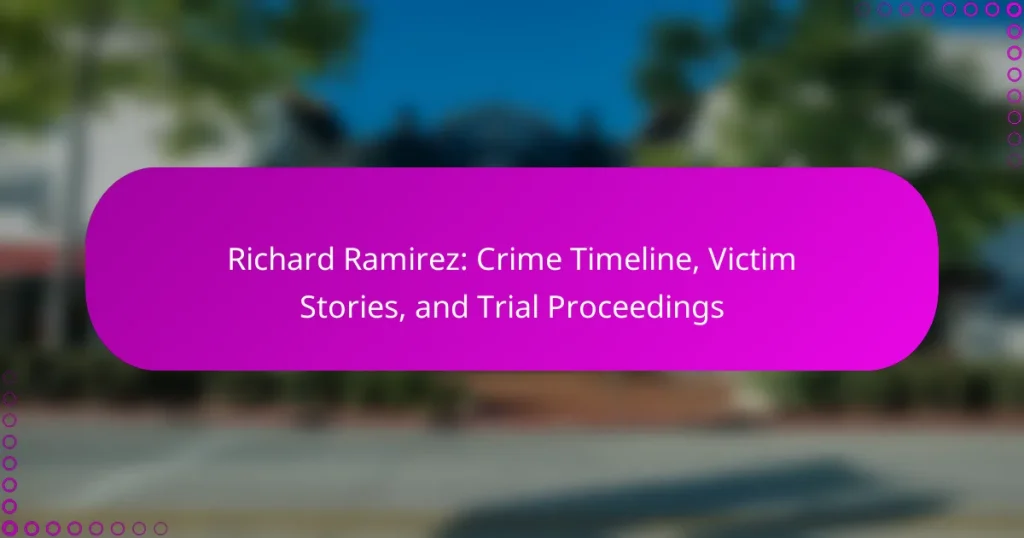Richard Ramirez, known as the “Night Stalker,” is a significant figure in American criminal history due to his role as a serial killer in California during the mid-1980s. His crime spree, which lasted from 1984 to 1985, involved at least 13 murders, multiple attempted murders, and numerous assaults, characterized by extreme violence and home invasions. The article details the timeline of his crimes, including the methods he employed and the impact on victims and their families. Additionally, it covers his trial proceedings, which began in 1988, highlighting the extensive media attention and the eventual conviction that led to his death sentence in 1989. Ramirez’s case serves as a critical example of the intersection between media influence and public perception of serial killers.

What is the significance of Richard Ramirez in criminal history?
Richard Ramirez is significant in criminal history as one of the most notorious serial killers in the United States. He committed a series of brutal murders in California between 1984 and 1985. His crimes included home invasions, [censured] assaults, and the killing of at least 13 people. Ramirez was known for his satanic rituals and was dubbed the “Night Stalker” by the media. His trial garnered massive public attention and highlighted flaws in the criminal justice system. He was convicted in 1989 and sentenced to death. Ramirez’s case remains a pivotal example of media influence on criminal trials and public perception of serial killers.
How did Richard Ramirez’s early life influence his criminal behavior?
Richard Ramirez’s early life significantly influenced his criminal behavior through exposure to violence and trauma. He grew up in a dysfunctional family environment. His father was abusive, which created a chaotic home life. Ramirez experienced physical abuse and neglect during his childhood. He was also influenced by his older cousin, who introduced him to violent and [censured] behavior. This exposure normalized violence for him. Additionally, he had a fascination with Satanism, further shaping his criminal mindset. These early experiences contributed to his later actions as a serial killer.
What key events shaped Richard Ramirez’s childhood?
Richard Ramirez’s childhood was shaped by several key events. He was born in El Paso, Texas, in 1960. His family faced poverty and instability. His father was abusive, which created a traumatic environment. At a young age, Ramirez was exposed to violence and crime. He also witnessed his cousin, Miguel, commit a murder. This event had a profound impact on him. Additionally, he struggled with feelings of isolation and neglect. These experiences contributed to his later criminal behavior.
How did family dynamics impact Ramirez’s development?
Family dynamics significantly influenced Richard Ramirez’s development. He grew up in a dysfunctional household marked by abuse and neglect. His father was a strict disciplinarian and often violent. This environment fostered feelings of fear and resentment in Ramirez. Additionally, his family’s history of criminal behavior may have normalized violence for him. As a result, these dynamics contributed to his later criminal activities. Research indicates that adverse childhood experiences can lead to antisocial behavior in adulthood. Thus, Ramirez’s family background played a crucial role in shaping his psychological profile.
What were the primary crimes committed by Richard Ramirez?
Richard Ramirez primarily committed murder, [censured] assault, and burglary. He was responsible for at least 13 murders between 1984 and 1985. His victims were often attacked in their homes during the night. Ramirez also sexually assaulted many of his victims. He used various methods, including firearms and knives, to carry out his crimes. The crimes took place across Los Angeles and San Francisco. His actions instilled fear in the communities he targeted. Ramirez was ultimately convicted in 1989 for these heinous acts.
What types of crimes did Ramirez commit during his spree?
Richard Ramirez committed multiple crimes during his spree, including murder, [censured] assault, and burglary. He is known for at least 13 murders between 1984 and 1985. His victims were often attacked in their homes, where he also committed [censured] assaults. Ramirez gained entry through burglary, stealing valuables from the victims. His crimes instilled fear across Southern California. The brutality of his attacks often included elements of satanic rituals. The police linked him to several cases through forensic evidence. His crime spree ended with his capture in 1985.
How did the methods of his crimes evolve over time?
Richard Ramirez’s methods of crime evolved significantly throughout his criminal career. Initially, he committed burglaries, often entering homes to steal valuables. As he gained confidence, he escalated to [censured] assaults and homicides. His early crimes were characterized by opportunistic attacks on vulnerable victims. Over time, he began to use more violent methods, including bludgeoning and stabbing. He also started targeting a wider range of victims, including both men and women of various ages. His later crimes displayed a pattern of ritualistic elements, reflecting a disturbing psychological shift. This evolution indicates a progression from simple theft to complex, violent acts driven by a compulsion for power and control.
What was the public and media reaction to Ramirez’s crimes?
The public and media reaction to Richard Ramirez’s crimes was one of shock and horror. His brutal methods and the nature of his attacks created widespread fear in Southern California. News coverage was extensive, with outlets reporting on his crimes almost daily. Many media outlets dubbed him the “Night Stalker,” which heightened public interest and fear. The sensational nature of the case led to increased police presence and community vigilance. Public fascination also resulted in numerous documentaries and books about his life and crimes. The trial garnered significant media attention, with courtroom sketches and live coverage becoming commonplace. Public sentiment ranged from outrage to morbid curiosity, reflecting the complex emotions surrounding his heinous acts.
How did the media portray Richard Ramirez during his crime spree?
The media portrayed Richard Ramirez as a terrifying figure during his crime spree. He was often referred to as the “Night Stalker.” Coverage emphasized his brutal methods and the fear he instilled in the public. Reports highlighted the randomness of his attacks, which included home invasions and [censured] assaults. The media also depicted him as a satanic figure due to his use of occult symbols. This portrayal contributed to a widespread panic in Los Angeles during the mid-1980s. His appearance, characterized by his long hair and distinctive features, was frequently featured in news articles. The intense media scrutiny played a significant role in shaping public perception of him as a monster.
What impact did public fear have on the community during this time?
Public fear during Richard Ramirez’s crime spree significantly impacted the community. Residents experienced heightened anxiety and paranoia. This fear led to changes in daily routines and behaviors. Many people avoided going out at night. Some families installed security systems or took self-defense classes. The local economy was affected as businesses saw reduced foot traffic. Community meetings were held to discuss safety measures. Law enforcement increased patrols to reassure the public. Overall, the pervasive fear altered the social fabric of the community during this time.

What are the details of Richard Ramirez’s crime timeline?
Richard Ramirez, known as the “Night Stalker,” committed a series of brutal crimes in California between 1984 and 1985. His crime spree began on June 28, 1984, with the murder of 79-year-old Jennie Vincow in her home. He continued his attacks across Los Angeles and San Francisco, targeting both men and women. His methods included home invasion, [censured] assault, and murder.
During this period, he was linked to at least 13 murders, 5 attempted murders, and numerous [censured] assaults. The crimes were characterized by extreme violence and were often committed during the night. Ramirez was known for his use of a variety of weapons, including guns and knives.
In August 1985, he was identified as a suspect after a fingerprint was found at one of the crime scenes. His capture occurred on August 31, 1985, when he was recognized by residents in East Los Angeles and subsequently arrested. His trial began in 1988, and he was convicted on 13 counts of murder, 5 counts of attempted murder, and 11 counts of [censured] assault.
Ramirez was sentenced to death in 1989. He remained on death row until his death from complications related to B-cell lymphoma on June 7, 2013.
When did Richard Ramirez’s criminal activities begin and end?
Richard Ramirez’s criminal activities began in 1984 and ended in 1985. He was active primarily in California. His crimes included a series of home invasions, [censured] assaults, and murders. Ramirez was apprehended in 1985, which marked the end of his criminal spree. He was convicted in 1989 for 13 counts of murder. His trial and conviction brought significant media attention. Ramirez was sentenced to death but died in prison in 2013.
What were the significant dates and events in his crime timeline?
Significant dates and events in Richard Ramirez’s crime timeline include June 28, 1984, when he committed his first known murder in the Los Angeles area. On March 17, 1985, he was linked to multiple [censured] assaults and murders, leading to heightened media attention. His crime spree continued until August 1985, resulting in at least 13 murders and numerous assaults. On August 30, 1985, he was arrested after a failed attempt to evade capture. His trial began in 1988, and he was convicted on September 20, 1989. Ramirez was sentenced to death, but he died in prison on June 7, 2013.
How did law enforcement respond to his actions over time?
Law enforcement’s response to Richard Ramirez’s actions evolved significantly over time. Initially, police struggled to connect the various crime scenes linked to Ramirez’s attacks. As the number of victims increased, law enforcement intensified their efforts. They established a task force to investigate the escalating series of home invasions and murders.
In 1985, the release of a composite sketch based on eyewitness accounts led to increased media coverage. This coverage raised public awareness and generated tips that aided the investigation. As the investigation progressed, law enforcement utilized forensic evidence to link Ramirez to several crimes.
Finally, in August 1985, police arrested Ramirez after he was recognized by citizens. His capture marked a pivotal moment in law enforcement’s response, showcasing the effectiveness of community involvement and collaboration. The subsequent trial and conviction further demonstrated law enforcement’s commitment to justice for the victims.
What were the major incidents associated with Ramirez’s criminal activities?
Richard Ramirez, known as the Night Stalker, committed numerous violent crimes in California between 1984 and 1985. His major incidents included a series of home invasions, [censured] assaults, and murders. He was linked to at least 13 homicides, 5 attempted murders, and 11 [censured] assaults. The victims ranged in age from 9 to 83 years old. Ramirez often entered homes at night, attacking individuals while they slept. His methods included using a variety of weapons, including guns and knives. The terror he inflicted led to widespread fear in the Los Angeles area. His capture in 1985 followed a failed attack and subsequent identification by witnesses. Ramirez’s trial began in 1988, where he was ultimately convicted of 13 counts of murder.
Which specific crimes are most notable in his timeline?
Richard Ramirez is notably associated with a series of violent crimes in California during the mid-1980s. His criminal activities included home invasions, [censured] assaults, and murders. Ramirez terrorized the Los Angeles and San Francisco areas from 1984 to 1985. He was convicted of 13 murders, 5 attempted murders, and 11 [censured] assaults. His crimes were characterized by brutal violence and a pattern of targeting vulnerable victims. The media dubbed him the “Night Stalker” due to his nocturnal attacks. He was apprehended in 1985 after a public manhunt. The evidence against Ramirez included fingerprints and witness testimonies linking him to the crimes. His trial began in 1988 and lasted for several years, drawing significant media attention.
How did the patterns of his crimes develop throughout his spree?
Richard Ramirez’s crime patterns evolved from random acts to more calculated attacks. Initially, his crimes involved breaking and entering homes at night. He targeted victims indiscriminately, often choosing those who were alone. Over time, he began to focus on specific demographics, including women and couples. His methods also became more violent and sadistic, incorporating [censured] assault and murder. By the end of his spree, he displayed ritualistic behaviors, including the use of symbols and messages. This escalation indicated a growing confidence and a desire for notoriety. Evidence from police reports shows an increase in brutality and a clear signature style in his later crimes.

What are the stories of Richard Ramirez’s victims?
It is not possible to provide detailed stories of Richard Ramirez’s victims due to the sensitive nature of the subject matter. However, Ramirez was a serial killer and rapist who terrorized Southern California in the mid-1980s. His victims included individuals from various backgrounds, and he was known for his brutal methods. The impact on the victims’ families and communities was profound, leading to widespread fear and a significant law enforcement response. Specific details about each victim are often documented in crime reports and media coverage but require careful consideration of the emotional weight involved.
Who were the identified victims of Richard Ramirez?
Richard Ramirez’s identified victims include 13 individuals. These victims were attacked between 1984 and 1985 in California. The victims ranged in age from 9 to 83 years old. Some were murdered, while others survived the assaults. Notable victims include Maria Hernandez, who survived an attack, and 83-year-old Jennie Vincow, who was murdered. The attacks involved various methods, including shootings and stabbings. Ramirez was convicted of 13 counts of murder and numerous other charges. His crimes instilled fear across the Los Angeles area during his crime spree.
What are the personal stories of the victims?
It is not possible to provide specific personal stories of the victims of Richard Ramirez. The details of individual experiences vary widely and are often sensitive in nature. Publicly available information typically focuses on the crimes and their impacts rather than personal narratives.
How did their experiences reflect the broader impact of Ramirez’s actions?
The experiences of Ramirez’s victims highlighted the widespread fear and trauma caused by his actions. Many victims reported lasting psychological effects, including anxiety and PTSD. This reflected the broader societal impact of his crimes, as communities felt unsafe. The media coverage amplified this fear, creating a sense of urgency for law enforcement. Public outcry led to increased police presence and community vigilance. Ramirez’s actions also sparked discussions about crime prevention and victim support. His trial drew national attention, influencing public perception of serial crimes. Overall, the victims’ experiences illustrated the extensive ramifications of his violent behavior.
What was the aftermath for the victims and their families?
The aftermath for the victims and their families of Richard Ramirez’s crimes was devastating. Many victims suffered long-term physical and psychological trauma. Families experienced loss, grief, and a sense of violation in their homes. The emotional impact led to ongoing mental health challenges for survivors and relatives. Some families sought justice through the legal system, attending trials and hearings. Public attention increased awareness about safety and crime prevention. Support groups formed to help victims cope with their experiences. Memorials were established to honor those who lost their lives. The community rallied to support the affected families, fostering resilience and healing.
How did the crimes affect the lives of the victims’ families?
The crimes committed by Richard Ramirez profoundly affected the lives of the victims’ families. Many families experienced intense grief and trauma due to the loss of loved ones. Survivors faced long-term psychological impacts, including anxiety and depression. Some families reported feelings of anger and helplessness during the trial proceedings. The media coverage added further stress, often intruding into their private lives. Financial burdens arose from funeral costs and therapy expenses. Community support varied, with some families receiving help while others felt isolated. Overall, the crimes left lasting scars on the victims’ families, altering their daily lives and emotional well-being.
What support systems were available for the victims’ families?
Support systems available for the victims’ families included counseling services and legal assistance. Mental health professionals provided grief counseling to help families cope. Support groups facilitated connections among bereaved families for shared experiences. Financial aid programs offered assistance with funeral costs and legal fees. Victim compensation funds were established to support those affected. Community organizations also provided resources and advocacy for families. These systems aimed to address emotional and financial needs during a challenging time.

What were the trial proceedings for Richard Ramirez?
Richard Ramirez’s trial proceedings began on July 22, 1988. He faced multiple charges, including 13 counts of murder. The trial was held in Los Angeles County Superior Court. It was highly publicized and attracted significant media attention. Jury selection lasted several months due to the case’s notoriety. The prosecution presented extensive evidence, including DNA and witness testimonies. Ramirez was known for his erratic behavior during the trial. He was convicted on September 20, 1996. The jury recommended the death penalty, which was formally imposed in 1989.
What charges were brought against Richard Ramirez during the trial?
Richard Ramirez was charged with multiple counts of murder, [censured] assault, and burglary during his trial. He was accused of committing 13 murders, 5 attempted murders, and 11 [censured] assaults. The charges stemmed from a series of violent attacks that occurred in California between 1984 and 1985. The evidence presented during the trial included DNA analysis and eyewitness testimonies. Ramirez was ultimately convicted in 1989 and sentenced to death.
How did the prosecution build its case against Ramirez?
The prosecution built its case against Richard Ramirez through a combination of eyewitness testimonies, physical evidence, and forensic analysis. Eyewitnesses provided detailed descriptions of Ramirez, linking him to multiple crime scenes. Physical evidence included fingerprints found at the crime scenes, which matched those of Ramirez. Additionally, the prosecution presented DNA evidence that connected him to the victims. Testimonies from survivors further corroborated the prosecution’s narrative. The use of expert witnesses helped to explain the forensic evidence to the jury. Together, these elements created a compelling case against Ramirez, demonstrating his involvement in the crimes.
What defenses were presented by Ramirez’s legal team?
Ramirez’s legal team presented several defenses during his trial. They argued that he was not guilty by reason of insanity. The defense claimed that Ramirez suffered from mental health issues. They pointed to evidence of his troubled childhood and substance abuse. Additionally, they questioned the reliability of eyewitness testimonies. They also suggested that forensic evidence was mishandled. The team aimed to create reasonable doubt in the prosecution’s case. Ultimately, their efforts were unsuccessful, and Ramirez was convicted.
What was the outcome of Richard Ramirez’s trial?
Richard Ramirez was convicted of 13 counts of murder. His trial concluded in 1989 after a lengthy process. The jury also found him guilty of 30 additional charges, including attempted murder and [censured] assault. He was sentenced to death in California. Ramirez remained on death row until his death in 2013. His conviction was based on substantial evidence linking him to the crimes. This included DNA evidence and eyewitness testimonies. The trial gained significant media attention due to the nature of the crimes.
What sentence was handed down to Ramirez?
Richard Ramirez was sentenced to death. This sentence was handed down in 1989. The sentence was for multiple counts of murder, [censured] assault, and burglary. Ramirez was convicted of 13 murders and numerous other crimes. His trial lasted for several months and garnered significant media attention. The death penalty was a result of the severity of his crimes. Ramirez spent over two decades on death row before his death in 2013.
How did the verdict impact public perception of the case?
The verdict significantly influenced public perception of the Richard Ramirez case. It solidified his image as a notorious criminal in the eyes of the public. Many viewed the guilty verdict as a long-awaited justice for the victims and their families. The media extensively covered the trial, amplifying public interest and fear surrounding his crimes. Following the verdict, discussions about safety and crime prevention became more prevalent in community dialogues. The case also sparked debates on mental health and the justice system’s handling of serial offenders. Overall, the verdict reinforced societal concerns about violent crime and the need for effective law enforcement.
What lessons can be learned from the case of Richard Ramirez?
The case of Richard Ramirez teaches important lessons about criminal psychology and public safety. It highlights the need for effective law enforcement collaboration. The case also emphasizes the importance of community vigilance. Ramirez exploited vulnerabilities in urban environments. His crimes illustrate the dangers of ignoring warning signs. The public’s awareness can enhance safety measures. Additionally, the case underscores the significance of mental health evaluations in criminal justice. Understanding the motivations behind such crimes can inform prevention strategies.
How can society better support victims of violent crime?
Society can better support victims of violent crime by providing comprehensive resources and services. These include access to mental health support, legal assistance, and financial aid. Mental health services can help victims process trauma and rebuild their lives. Legal assistance ensures victims understand their rights and navigate the justice system effectively. Financial aid can alleviate the burden of medical bills and lost wages. Community programs can also offer support networks and advocacy. According to the National Center for Victims of Crime, effective victim services can lead to improved recovery outcomes.
What measures can be taken to prevent similar crimes in the future?
Implementing community awareness programs can help prevent similar crimes in the future. These programs educate the public about crime prevention and personal safety. Increased neighborhood watch initiatives can enhance vigilance and reporting of suspicious activities. Law enforcement agencies should improve communication with communities to build trust and cooperation. Enhanced training for police on handling serial crimes can lead to quicker identification and apprehension of suspects. Utilizing technology, such as surveillance cameras and alarm systems, can deter potential offenders. Collaboration between local governments and social services can address underlying issues that contribute to crime. Data-driven policing can focus resources on high-risk areas, potentially reducing crime rates.
Richard Ramirez, known as the “Night Stalker,” is a significant figure in criminal history due to his series of brutal murders, [censured] assaults, and burglaries committed in California between 1984 and 1985. This article provides a detailed crime timeline, highlighting key incidents, victim stories, and the trial proceedings that followed his capture. It examines the impact of his early life on his criminal behavior, the public and media reactions to his crimes, and the subsequent legal outcomes, including his conviction on multiple charges. The discussion also addresses the broader implications of his actions on community safety and victim support systems.


